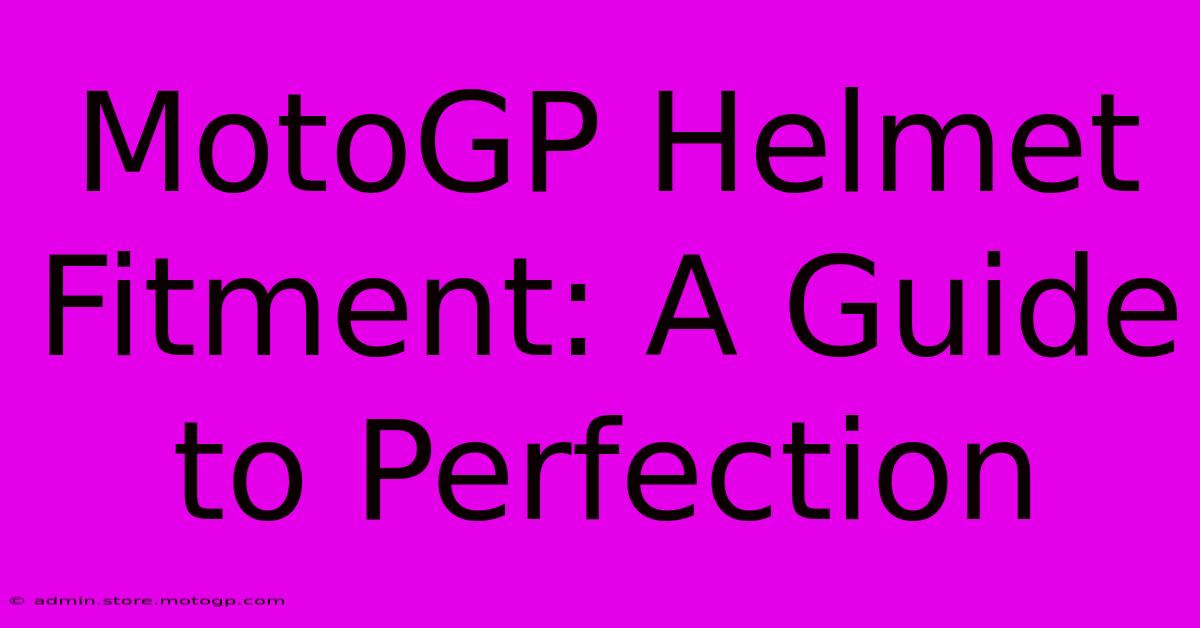MotoGP Helmet Fitment: A Guide To Perfection

Table of Contents
MotoGP Helmet Fitment: A Guide to Perfection
Finding the perfect MotoGP helmet fit is crucial for both performance and safety. A poorly fitting helmet can lead to discomfort, reduced visibility, and even increased risk of injury during a crash. This guide will walk you through the process of achieving that perfect fit, ensuring your helmet is as much a part of you as your bike.
Why Proper Fit Matters
Before diving into the specifics, let's understand why proper fit is paramount:
- Safety: In a crash, a poorly fitting helmet can shift, exposing vulnerable areas to impact. A secure fit minimizes this risk.
- Comfort: A helmet that's too tight can cause headaches and pressure points, leading to fatigue and distraction. A helmet that's too loose can be noisy and unstable.
- Performance: A secure fit prevents the helmet from moving during high-speed maneuvers, improving your vision and reducing distractions.
- Communication: A properly fitting helmet ensures a better seal for communication systems, making it easier to hear your team or fellow riders.
Measuring Your Head
The first step to finding the perfect fit is accurately measuring your head circumference. Here's how:
- Use a flexible tape measure: A soft tape measure is essential for accurate readings.
- Measure at the widest point: Place the tape measure around your head, just above your eyebrows and ears.
- Keep it level: Ensure the tape measure sits level and comfortable.
- Record the measurement: Note down your measurement in centimeters. Many helmet manufacturers use centimeters for sizing.
Trying On Your Helmet
Once you have your measurement, it's time to try on helmets:
- Visit a reputable dealer: This is crucial! A knowledgeable retailer can guide you through the fitting process.
- Try multiple brands and sizes: Different brands have different sizing charts. Don't be afraid to try on several helmets, even within the same size range.
- Wear the helmet properly: Ensure the helmet sits squarely on your head, covering your forehead and temples.
- Check for pressure points: A properly fitting helmet shouldn't have any significant pressure points. Minor pressure is normal but shouldn't be painful.
- Assess the cheek pads: The cheek pads should snugly fit against your cheeks, allowing you to open and close your mouth without difficulty.
- Test the chin strap: The chin strap should secure the helmet firmly without being overly tight. You should be able to fit two fingers comfortably under the strap when fastened.
- Look for movement: Gently try to move the helmet. A proper fit will show minimal movement. It should feel secure and stable.
- Consider the liner: Check the comfort of the liner; it's crucial for long rides.
Key indicators of a poor fit:
- Pain or discomfort: Significant pressure points or persistent discomfort are major red flags.
- Excessive movement: The helmet shouldn't wobble or shift easily.
- Difficulty closing the visor: The helmet should not inhibit the easy operation of the visor.
- Pressure on the temples or forehead: This might suggest the helmet is too narrow.
Helmet Types and Fit
Different helmet types (full-face, modular, open-face) might fit slightly differently. Be sure to try on the specific type of helmet you intend to use.
After Purchase: Breaking In Your Helmet
Even a perfectly fitting helmet might require a slight break-in period. The liner will conform to your head shape over time. This is normal, and discomfort should diminish gradually. However, persistent discomfort is an indication of a poor fit and you should contact the retailer immediately.
Maintaining Your Helmet Fit
Regularly check the condition of your helmet's interior padding. Replacing worn-out padding will help maintain a secure and comfortable fit and prolong the life of your helmet.
Conclusion: Safety First!
Investing the time and effort to ensure a perfect helmet fit is an investment in your safety and riding experience. A properly fitting helmet is crucial for comfort, performance, and the most important factor - safety on the track or road. Don't compromise – get the perfect fit. Your peace of mind is worth it.

Thank you for visiting our website wich cover about MotoGP Helmet Fitment: A Guide To Perfection. We hope the information provided has been useful to you. Feel free to contact us if you have any questions or need further assistance. See you next time and dont miss to bookmark.
Featured Posts
-
Get Closer To The Drivers F1 Houston
Feb 19, 2025
-
Moto2 Specifications The Ultimate Guide To Moto2 Racing
Feb 19, 2025
-
Experience Moto Gp Live Austin Dates Inside
Feb 19, 2025
-
Inside Yamahas Moto Gp Strategy Exclusive Team News
Feb 19, 2025
-
Cota Grandstand Tickets Dont Delay
Feb 19, 2025
